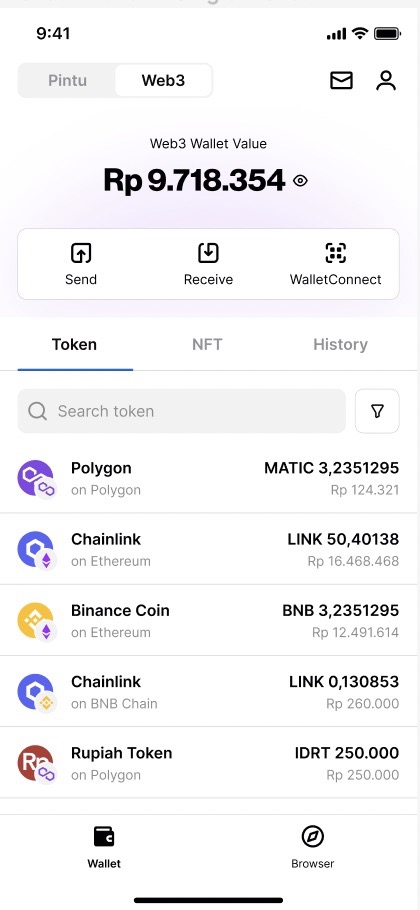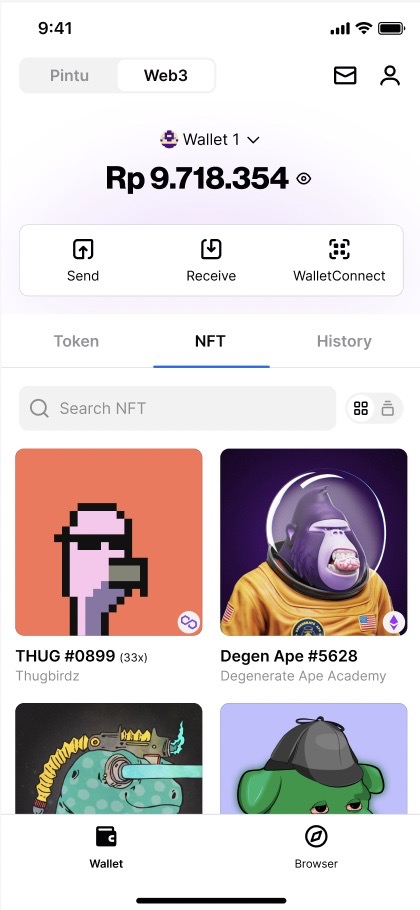Maximizing crypto profits goes beyond just trading. The crypto world offers diverse opportunities, with various ecosystems like NFTs, GameFi, and DeFi emerging within the Web3. Accessing these Web3 applications requires a secure wallet compatible with multiple blockchains. This article explores how a Web3 wallet can enhance your crypto experience.
Article Summary
- 💰 A Web3 wallet serves as more than just a storage for crypto assets. It also facilitates the utilization of Web3 technology. Examples include Metamask, Phantom, Trust Wallet, and Pintu Web3 Wallet.
- 🌏 A Web3 wallet functions as your identity within the Web3 ecosystem. With just one Web3 wallet, you can access multiple Web3 applications without needing separate accounts.
- 🔰 A Web3 wallet featuring MPC (Multi-Party Computation) technology provides advanced security and self-custody, enhancing the overall security of the Web3 ecosystem.
- 🎉The Pintu app now features the Pintu Web3 Wallet, allowing seamless access to multiple Web3 applications within a single platform.
Overview of Web3 Wallet
What exactly is a Web3 wallet? It’s a crypto wallet designed not just to store and manage crypto but also to integrate with Web3 technology seamlessly. With a Web3 wallet, users can connect to several decentralized applications (dApps), engage in NFT trading, participate in blockchain-based gaming, and even hunt airdrops, all from a single platform.
Web3 wallets give users direct control over their private keys, allowing them to fully own their crypto and participate in the decentralized ecosystem. Some examples of Web3 wallets are Metamask, Phantom, Trust Wallet, and Web3 Wallet Door.
Keep in mind that a Web3 wallet does not directly store your crypto. Your assets are safely stored on the blockchain network (for example, ETH on the Ethereum blockchain or SOL on the Solana blockchain). The wallet serves as an interface to manage your assets located on the blockchain network.
Read also: 8 Use Cases of Web3 Wallet in the Blockchain Ecosystem.
Why do you need a Web3 wallet?
Essentially, a Web3 wallet acts as your identity within the Web3 ecosystem. With just one Web3 wallet, there’s no need to create accounts using different email addresses and passwords to access various Web3 applications.
As the Web3 ecosystem grows, there are a lot of exciting dApps on various networks that offer profit opportunities. For example, you can take advantage of lending and borrowing platforms like Aave, hunt airdrops by transacting on multiple platforms, and connect to Web3’s various social media on Lens Protocol or CyberConnect.


Each blockchain typically operates within its own ecosystem, accompanied by its respective wallet. Ethereum and Solana, as major blockchains, possess their unique ecosystems and associated wallets. Nonetheless, certain Web3 wallets now facilitate access to multiple major blockchains within a single application. For instance, Pintu Web3 Wallet enables access to various dApps across Ethereum, BNB Smart Chain, Polygon, Avalanche, and more.
As the Web3 ecosystem advances, the potential for leveraging various benefits through DeFi platforms grows significantly. With a Web3 wallet, you can explore several platforms facilitating liquid staking, L2, DePIN, RWA, and other functionalities.
Here are some advantages of the Pintu Web3 Wallet as a gateway to explore the world of Web3.
1. User-Friendly Interface
The Web3 wallet features a straightforward and intuitive interface. Users require no specialized knowledge to utilize this wallet, and its setup process is remarkably straightforward.
2. Integrated with the Expansive Web3 Ecosystem
A Web3 wallet not only stores crypto assets and NFTs but also grants access to diverse Web3 applications across various blockchain networks. Thus, ensure that your Web3 wallet supports the specific blockchain network you intend to use, simplifying your transaction process.
3. Self-custody Over Assets
With ownership of a seed phrase comes complete control over all assets within. Despite Web3 wallets being developed by third parties, access to the wallet is only granted to users possessing the seed phrase and private keys. Therefore, the wallet creator, being a third party, cannot access your wallet.
4. High Security in Web3 wallets
The DeFi ecosystem in the Web3 world is a sector that is vulnerable to hacking and fraud. Therefore, innovations in Web3 wallet technology aim to provide a high level of security in protecting wallets. One such solution involves the adoption of multi-party computation (MPC) technology. This method divides private keys and distributes them across various trusted parties, thereby reducing the risk of unauthorized access and bolstering wallet security.
Web3 Wallets Utilizing MPC Technology
In contrast to conventional Web3 wallets, which mandate the secure storage of seed phrases, those integrating MPC technology, known as MPC wallets, eliminate the necessity of seed phrase storage altogether. Pintu Web3 Wallet employs this innovative MPC technology.
So, where are the private keys of MPC wallets stored?
When you create a new wallet, the MPC system automatically divides the private key into multiple fragments, encrypts them, and distributes them among several trusted entities. Additionally, the user retains a portion of the private key in the form of a key share, granting them complete access to the wallet.
In this manner, users maintain complete access to their wallets without storing their whole private key. While the trusted entities securely store the fragmented private key, they are unable to access the wallet due to the user holding a portion of the private key.
In other words, hacking and stealing private keys in MPC wallets becomes very difficult because hackers need to gather all fragmented parts to access a wallet.
The benefits of using an MPC wallet include high security, full decentralization, and self-custody. These features make exploring the Web3 ecosystem both easier and safer for users.
Read more in What is MPC Wallet?
It's important to recognize that certain Web3 wallets still depend on a seed phrase or a list of words for wallet access. Losing this seed phrase or private key could permanently lose access to crypto assets. Recovering a wallet with a seed phrase is challenging, as no external entity can assist in its recovery. Therefore, securely storing your seed phrase is crucial to maintaining access to your wallet.
Learn more about the difference between Seed Phrase, Private Key, and Public Key.
Pintu Web3 Wallet on Pintu App
Pintu has recently launched its Web3 Wallet, seamlessly integrated within the Pintu app. This wallet enables you to send, receive, and store crypto while also providing access to several dApps such as OpenSea, PancakeSwap, Blur, and more.
Pintu Web3 Wallet supports multi-chain networks, including Ethereum, BNB Smart Chain, Polygon, Avalanche and more. This allows you to interact with smart contracts and dApps across various blockchain networks using just one wallet.
With Pintu Web3 Wallet, you can actively engage in the decentralized future of the internet and participate in diverse Web3 projects.
Let’s create your Web3 Wallet on Pintu app. Watch this video to learn how to create one.
Summary
Having a Web3 wallet is essential for accessing the vast opportunities in investment, entertainment, and education within the Web3 world. Popular Web3 wallets today require secure storage of seed phrases to safeguard against unauthorized access.
However, a challenge arises if a user misplaces the seed phrase and private key, resulting in the loss of all assets within the wallet. Therefore, MPC wallets offer a solution by granting users full control without the requirement to maintain the seed phrase intact. This enhances security and convenience within the Web3 ecosystem.
References
- Graphtronauts, What is a Web3 Wallet and Why You Absolutely Need One, Medium, accessed 9 January 2023.
- Ruholamin Haqshanas, Seed Phrase, Techopedia, accessed 9 January 2023.
- Siyu Ren Heinrich, Web3 Wallets: What Are They and Should You Use One? Tastycrypto, accessed 9 January 2023.
